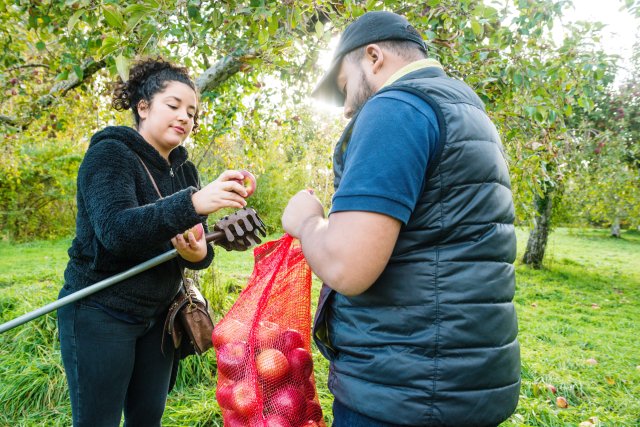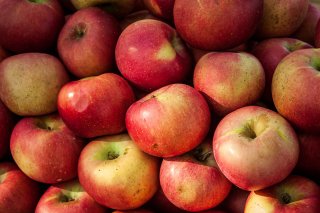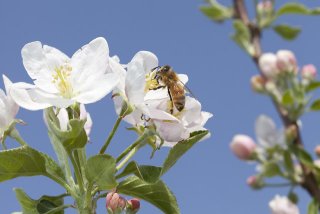Climate Change Connections: New York (Apples)
Climate change is impacting all regions and sectors of the United States. The State and Regional Climate Change Connections resource highlights climate change connections to culturally, ecologically, or economically important features of each state and territory. The content on this page provides an illustrative example. As climate change will affect each state and territory in diverse ways, this resource only describes a small portion of these risks. For more comprehensive information about regional climate impacts, please visit the Fifth National Climate Assessment and Climate Change Impacts by Sector.
On this page:
Introduction: Apple Growing Conditions in New York

New York is well known for its state fruit, the apple. The state’s most populous city, New York City, is even referred to as “The Big Apple.” Compared with other states, New York State is the second-largest apple producer in the country. New York orchards produced over 1.2 billion pounds of apples in 2022—more than the weight of the Empire State Building.1 Valued at nearly $400 million in 2022, apple production represents a large portion of the state’s agricultural sector.1 Apple picking is a popular fall activity, with many New York orchards offering “pick your own” days for visitors to fill their baskets with the crisp fruit. The Empire State is also well known for its hard cider (an alcoholic form of apple cider made from fermented juice).
Apples require a certain number of chilling days to flower in spring and produce fruit normally.2 When temperatures warm up, the trees start to blossom. However, if an apple tree blooms too early due to warm temperatures followed by a sudden cold snap, its blossoms can be damaged by frost.
Apples in New York are often grown near large bodies of water, such as Lake Erie and Lake Ontario. Apples thrive in these areas because large bodies of water help moderate extreme temperatures.3 Water warms and cools slower than air does, so large lakes tend to be warmer than the air in the fall and cooler than the air in the spring. In fall and winter, water bodies keep the surrounding area warmer than it would otherwise be. The moderating effect of water helps reduce frost and cold damage to apples. In spring, orchards near large bodies of water stay cooler for longer, which protects them from heat damage. Cool air also delays the bloom of apple flowers so that they blossom after the threat of frost has passed.3

Climate Impacts: A Warming Climate Could Lead to Earlier Blooms and Damaged Fruit
As the Earth warms, average temperatures increase throughout the year. However, these increases may be greater in certain seasons than in others. Winter is particularly affected by rising temperatures, as minimum temperatures have increased at a higher rate than average maximum temperatures.4 Much of the observed warming in the United States has occurred when and where it is coldest—during winter,4 at night, and in the northern parts of the country. Seasonal warming could disrupt the timing of events that are important for plants and animals, such as budding, flower blooms, hibernation, egg-laying, hatching, and migration.
Climate change is expected to bring warmer summers and milder winters to New York.5,6 Average temperatures in the state have already risen by almost 2.5°F since the beginning of the 20th century, with most of this warming happening in winter and spring.6 The Great Lakes have been warming and experiencing a decrease in ice cover duration over the last few decades.7,8 These warming trends are expected to continue in the future.9 Warmer lake waters reduce the cooling effect that lakes normally provide for apple orchards during the spring. Warmer temperatures earlier in the year, combined with a reduced buffering effect from lakes, could cause apples to blossom too soon and be damaged by late-season frosts.3

As spring temperatures warm,10 the impacts of sporadic spring frosts are already being felt by apple growers in New York.11 In 2012 and 2017, unusually warm spring temperatures were followed by a freezing period. These spring frosts resulted in significant crop losses across the state.11 In a changing climate, late spring frost damage could become more common.12 Apple flowers in New York are projected to bloom about 15 days earlier by the end of the century compared to current bloom dates.13 Decreasing apple yields from damaged crops could lead to millions of dollars in lost revenue for New York orchards and could affect the state’s billion-dollar cider industry.13
High temperatures can cause a variety of imperfections in apples. These effects include apple sunburn,14 which leads to lower apple quality and decreases the fruit’s market value. Warmer temperatures could also make conditions more favorable for apple pests, such as the codling moth,15,16 and could motivate farmers to apply more insecticide. Higher humidity, another expected result of climate change, can enhance disease risk for specialty crops, including apples.9
Taking Action: Managing Apple Production in a Changing Climate
Addressing climate change requires reducing greenhouse gas emissions while preparing for and protecting against current and future climate impacts. Communities, public officials, and individuals in every part of the United States can continue to explore and implement climate adaptation and mitigation measures. In New York, farmers and researchers are investigating different strategies for promoting orchard resilience in a changing climate, including:
- Frost management on farms. Short-term solutions to prevent frost damage include using wind machines, sprinklers, and heaters to increase orchard temperatures. However, these technologies are often costly, impractical, and only effective down to a few degrees below freezing.17 Decision tools that integrate weather forecasts into early-warning systems for frost risk, such as the Northeast Regional Climate Center’s Apple Frost Risk Maps, can show growers when to use preventative technologies.
- Resilient cultivars. Long-term adaptation strategies for New York apple growers could include cultivating apple varieties that are more tolerant of extreme temperatures. However, apple orchards typically last 20 years or more, so it is not as easy to switch apple types as it is to switch annual crops. Scientists are researching methods to genetically modify apples to make them more resilient to frost.17 Because consumers already prefer certain apple varieties, such as Gala, shifting to growing different types of apples could also require new consumer marketing techniques.13 New apple varieties will not only need to be resilient to a changing climate, but also suitable for local soil types, farming practices, and consumer preferences.
To learn more about climate change impacts in New York and the Northeast region, see Chapter 21 of the Fifth National Climate Assessment.
Related Resources
- EPA Climate Change Indicators: Seasonal Temperature
- Climate, Weather and Apples (U.S. Department of Agriculture)
- New York State Climate Summary 2022 (NOAA)
- New York State Climate Impacts Assessment (New York State Energy Research and Development Authority)
References
1 U.S. Department of Agriculture National Agricultural Statistics Service. (2024). 2023 state agriculture overview: New York. https://www.nass.usda.gov/Quick_Stats/Ag_Overview/stateOverview.php?state=NEW%20YORK
2 Morton, L. W., Cooley, D., Clements, J., & Gleason, M. (2017). Climate, weather and apples (Sociology Technical Report No. 1046). Department of Sociology, Iowa State University. https://www.climatehubs.usda.gov/sites/default/files/Climate,%20Weather%20and%20Apples_0.pdf
3 Warren II, R. J., & Vermette, S. (2022). Laurentian Great Lakes warming threatens northern fruit belt refugia. International Journal of Biometeorology, 66(4), 669–677. https://doi.org/10.1007/s00484-021-02226-6
4 U.S. Global Change Research Program. (2017). Climate science special report: Fourth National Climate Assessment, volume I (D. J. Wuebbles, D. W. Fahey, K. A. Hibbard, D. J. Dokken, B. C. Stewart, & T. K. Maycock, Eds.). U.S. Global Change Research Program. https://doi.org/10.7930/J0J964J6
5 New York State Energy Research and Development Authority. (2011). Responding to climate change in New York State: The ClimAID integrated assessment for effective climate change adaptation in New York State (No. 11–18). https://www.nyserda.ny.gov/About/Publications/Energy-Analysis-Reports-and-Studies/Environmental-Research-and-Development-Technical-Reports/Response-to-Climate-Change-in-New-York
6 Frankson, R., Kunkel, K. E., Champion, S. M., Stewart, B. C., Sweet, W., DeGaetano, A. T., & Spaccio, J. (2022). New York state climate summary 2022 (NOAA Technical Report NESDIS 150-NY). NOAA National Environmental Satellite, Data, and Information Service. https://statesummaries.ncics.org/chapter/ny/
7 EPA. (2021). Climate change indicators: Great Lakes water levels and temperatures. Retrieved August 21, 2023, from https://www.epa.gov/climate-indicators/great-lakes
8 EPA. (2021). Climate change indicators: Great Lakes ice cover. Retrieved December 20, 2023, from https://www.epa.gov/climate-indicators/climate-change-indicators-great-lakes-ice-cover
9 Wilson, A. B., Baker, J. M., Ainsworth, E. A., Andresen, J., Austin, J. A., Dukes, J. S., Gibbons, E., Hoppe, B. O., LeDee, O. E., Noel, J., Roop, H. A., Smith, S. A., Todey, D. P., Wolf, R., & Wood, J. D. (2023). Ch. 24. Midwest. In A. R. Crimmins, C. W. Avery, D. R. Easterling, K. E. Kunkel, B. C. Stewart, & T. K. Maycock (Eds.), Fifth National Climate Assessment. U.S. Global Change Research Program. https://doi.org/10.7930/NCA5.2023.CH24
10 EPA. (2022). Climate change indicators: Seasonal temperature. Retrieved June 11, 2024, from https://www.epa.gov/climate-indicators/climate-change-indicators-seasonal-temperature
11 DeGaetano, A. (2017, May 4). In the Northeast, just one cold day can keep the apples away. Beyond the Data. http://www.climate.gov/news-features/blogs/beyond-data/northeast-just-one-cold-day-can-keep-apples-away
12 Zohner, C. M., Mo, L., Renner, S. S., Svenning, J.-C., Vitasse, Y., Benito, B. M., Ordonez, A., Baumgarten, F., Bastin, J.-F., Sebald, V., Reich, P. B., Liang, J., Nabuurs, G.-J., de-Miguel, S., Alberti, G., Antón-Fernández, C., Balazy, R., Brändli, U.-B., Chen, H. Y. H., … Crowther, T. W. (2020). Late-spring frost risk between 1959 and 2017 decreased in North America but increased in Europe and Asia. Proceedings of the National Academy of Sciences, 117(22), 12192–12200. https://doi.org/10.1073/pnas.1920816117
13 Wolfe, D. W., DeGaetano, A. T., Peck, G. M., Carey, M., Ziska, L. H., Lea-Cox, J., Kemanian, A. R., Hoffmann, M. P., & Hollinger, D. Y. (2018). Unique challenges and opportunities for northeastern US crop production in a changing climate. Climatic Change, 146(1–2), 231–245. https://doi.org/10.1007/s10584-017-2109-7
14 Morales-Quintana, L., Waite, J. M., Kalcsits, L., Torres, C. A., & Ramos, P. (2020). Sun injury on apple fruit: Physiological, biochemical and molecular advances, and future challenges. Scientia Horticulturae, 260, 108866. https://doi.org/10.1016/j.scienta.2019.108866
15 Hirschi, M., Stoeckli, S., Dubrovsky, M., Spirig, C., Calanca, P., Rotach, M. W., Fischer, A. M., Duffy, B., & Samietz, J. (2012). Downscaling climate change scenarios for apple pest and disease modeling in Switzerland. Earth System Dynamics, 3(1), 33–47. https://doi.org/10.5194/esd-3-33-2012
16 Senft, D. (1997, May). With IPM, bigger areas are better. Agricultural Research, 45(5). https://agresearchmag.ars.usda.gov/1997/may/codling/
17 Wisniewski, M. E., Artlip, T. S., & Norelli, J. L. (2016). Dealing with frost damage and climate change in tree fruit crops. New York Fruit Quarterly, 24(3), 25–28. https://nyshs.org/wp-content/uploads/2016/10/Wisniewski-Pages-25-28-from-NYFQ-Book-Fall-2016-5.pdf

